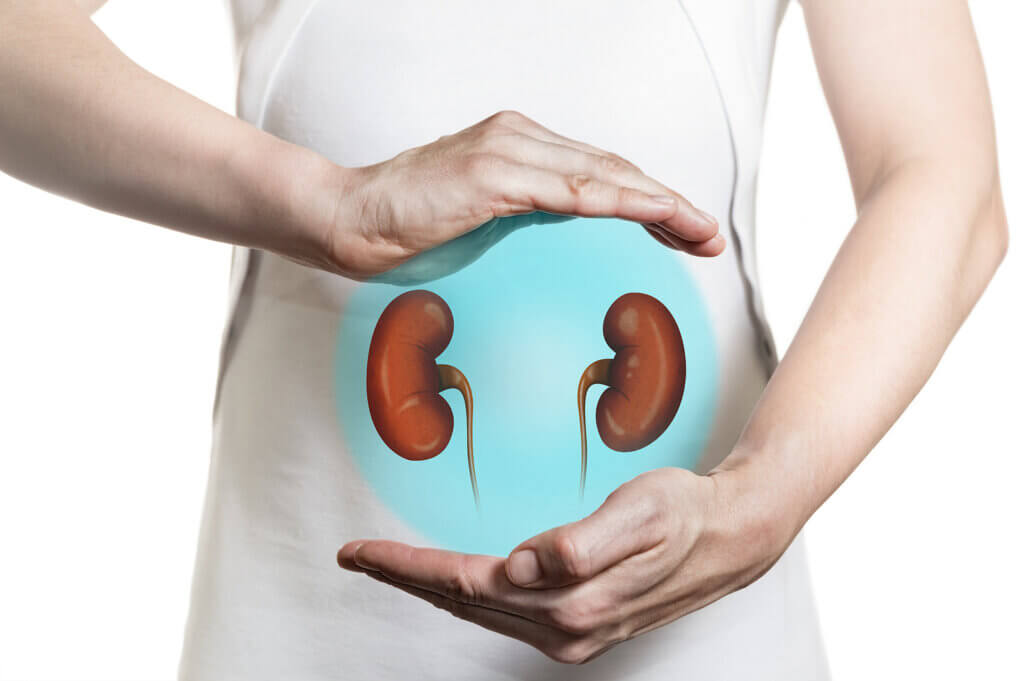What Is Asterixis?

You may have never heard of the term asterixis, which is related to a medical condition. But what is it? Asterixis is a clinical sign that describes the inability to maintain the joints of the hands in a certain position, resulting in involuntary repetitive movements.
We’re talking here about continuous and uncontrollable shaking of the hands and legs. This type of motor disorder is called negative myoclonus because it’s characterized by a brief loss of tone in the agonist muscles of the hands and wrist, followed by jerking in the antagonist muscles.
The curious origin of the word
This phenomenon was first described in 1949 by James Foley and Raymond Adams, to describe the joint flapping that they observed in patients with liver disease. They had originally coined the term anisosterixis, but considered it a difficult word to pronounce. So Foley and Adams shortened it to asterixis.
The term began to be used among physicians, because Adams was part of the editors of the world-class textbook of Internal Medicine. This is the well-known Harrison’s Textbook of Medicine.
How is asterixis diagnosed?
The maneuver that we’re going to describe next is performed by the doctor during the consultation to confirm the presence of this sign. The expert can cause asterixis to appear by asking the person to close their eyes and extend their arms.
You should keep your arms, hands, and fingers hyperextended (as if you were pushing a wall with your hands). If the patient has the disorder, there will be a kind of brief involuntary fluttering or sudden jerks in the wrists, of varying intensity.
Although asterixis is most commonly seen in the wrist, it can be stimulated at the hip joint as well. The person is placed on their back and asked to bend their knees, keeping their feet flat on the table, allowing the knees to drop sideways. At that moment, the flapping of the knees will be seen if the maneuver is positive.

Despite investigations, the cause is not yet known
The exact mechanism by which asterixis occurs remains uncertain. One of the most plausible hypotheses seems to be the existence of an abnormality in the functioning of the motor centers found in the brain, which are responsible for coordinating the tone of the muscles.
Electrophysiological studies have revealed the appearance of sharp negative waves in the contralateral central area. This is suggestive of abnormal activity in the motor field of the cortex.
Diseases that can present with asterixis
Asterixis has been associated with multiple pathologies. It’s a rare but significant sign of central nervous system damage.
Bilateral asterixis can present in patients with the following conditions:
- Hepatic failure, accompanied by hepatic encephalopathy
- Heart or respiratory failure
- Electrolyte disturbances: hypokalemia or hypomagnesemia.
- By drugs: intoxication with phenytoin leading to a flutter of phenytoin, barbiturates, valproate, gabapentin, lithium, and metoclopramide.
Unilateral asterixis is caused by a focal lesion in the thalamus (in 54% of cases). The most common cause is hemorrhage or ischemia at this level.
Hepatic encephalopathy
Hepatic encephalopathy is the most common cause of asterixis. It’s a neuropsychiatric syndrome that can occur in patients with advanced cirrhosis and there are various degrees of severity.
When liver function is compromised, the ammonia that should be removed from the body is not converted to urea and accumulates in the brain, injuring it. This leads to the development of various neurological symptoms, among them asterixis.
Although for many years it was believed that this was the main damage mechanism, today it is known that an altered intestinal flora (microbiota) and malnutrition with loss of muscle mass (sarcopenia), among other factors, can produce edema in the brain.
Is there a specific treatment for asterixis?
Given that asterixis is a sign, but not a disease, the treatment of the patient with this condition will depend on the underlying cause.
In the case of hepatic encephalopathy, the approach is based on the following principles:
- Protein restriction is avoided as before, as it can worsen hepatic encephalopathy.
- Fiber intake is increased, which favors the elimination of nitrogen through the gastrointestinal tract.
- Administration of formulas rich in branched-chain amino acids and L-ornithine-L-aspartate (LOLA) intravenously is beneficial in cases that don’t respond to lactulose.
- Minerals, such as zinc, and manganese chelating agents are administered. At the same time, urea and taurine transporter proteins are supplied. This can be combined with the so-called new therapeutic targets for liver failure, involving gene therapy, FKS1 protein inhibitors, fecal transplantation of intestinal flora.
If the cause of asterixis is any medication, the recommended treatment is to stop taking it or reduce the dose, as the case may be. The treating physician should always be consulted to make this decision, since most of these substances are anticonvulsants or antipsychotics.
In a patient with uremia secondary to kidney failure, dialysis may be helpful. In this case, the procedure can remove waste products that the kidney cannot remove on its own.

Diagnosis and treatment of asterixis must be timely
A person with asterixis may not be affected by their daily activities, as this sign doesn’t appear when resting. However, the quality of life decreases.
The causative disease must be studied promptly. In order to do this, the doctor will take a detailed medical history, a corresponding physical examination, and laboratory tests to rule out differential diagnoses.
You may have never heard of the term asterixis, which is related to a medical condition. But what is it? Asterixis is a clinical sign that describes the inability to maintain the joints of the hands in a certain position, resulting in involuntary repetitive movements.
We’re talking here about continuous and uncontrollable shaking of the hands and legs. This type of motor disorder is called negative myoclonus because it’s characterized by a brief loss of tone in the agonist muscles of the hands and wrist, followed by jerking in the antagonist muscles.
The curious origin of the word
This phenomenon was first described in 1949 by James Foley and Raymond Adams, to describe the joint flapping that they observed in patients with liver disease. They had originally coined the term anisosterixis, but considered it a difficult word to pronounce. So Foley and Adams shortened it to asterixis.
The term began to be used among physicians, because Adams was part of the editors of the world-class textbook of Internal Medicine. This is the well-known Harrison’s Textbook of Medicine.
How is asterixis diagnosed?
The maneuver that we’re going to describe next is performed by the doctor during the consultation to confirm the presence of this sign. The expert can cause asterixis to appear by asking the person to close their eyes and extend their arms.
You should keep your arms, hands, and fingers hyperextended (as if you were pushing a wall with your hands). If the patient has the disorder, there will be a kind of brief involuntary fluttering or sudden jerks in the wrists, of varying intensity.
Although asterixis is most commonly seen in the wrist, it can be stimulated at the hip joint as well. The person is placed on their back and asked to bend their knees, keeping their feet flat on the table, allowing the knees to drop sideways. At that moment, the flapping of the knees will be seen if the maneuver is positive.

Despite investigations, the cause is not yet known
The exact mechanism by which asterixis occurs remains uncertain. One of the most plausible hypotheses seems to be the existence of an abnormality in the functioning of the motor centers found in the brain, which are responsible for coordinating the tone of the muscles.
Electrophysiological studies have revealed the appearance of sharp negative waves in the contralateral central area. This is suggestive of abnormal activity in the motor field of the cortex.
Diseases that can present with asterixis
Asterixis has been associated with multiple pathologies. It’s a rare but significant sign of central nervous system damage.
Bilateral asterixis can present in patients with the following conditions:
- Hepatic failure, accompanied by hepatic encephalopathy
- Heart or respiratory failure
- Electrolyte disturbances: hypokalemia or hypomagnesemia.
- By drugs: intoxication with phenytoin leading to a flutter of phenytoin, barbiturates, valproate, gabapentin, lithium, and metoclopramide.
Unilateral asterixis is caused by a focal lesion in the thalamus (in 54% of cases). The most common cause is hemorrhage or ischemia at this level.
Hepatic encephalopathy
Hepatic encephalopathy is the most common cause of asterixis. It’s a neuropsychiatric syndrome that can occur in patients with advanced cirrhosis and there are various degrees of severity.
When liver function is compromised, the ammonia that should be removed from the body is not converted to urea and accumulates in the brain, injuring it. This leads to the development of various neurological symptoms, among them asterixis.
Although for many years it was believed that this was the main damage mechanism, today it is known that an altered intestinal flora (microbiota) and malnutrition with loss of muscle mass (sarcopenia), among other factors, can produce edema in the brain.
Is there a specific treatment for asterixis?
Given that asterixis is a sign, but not a disease, the treatment of the patient with this condition will depend on the underlying cause.
In the case of hepatic encephalopathy, the approach is based on the following principles:
- Protein restriction is avoided as before, as it can worsen hepatic encephalopathy.
- Fiber intake is increased, which favors the elimination of nitrogen through the gastrointestinal tract.
- Administration of formulas rich in branched-chain amino acids and L-ornithine-L-aspartate (LOLA) intravenously is beneficial in cases that don’t respond to lactulose.
- Minerals, such as zinc, and manganese chelating agents are administered. At the same time, urea and taurine transporter proteins are supplied. This can be combined with the so-called new therapeutic targets for liver failure, involving gene therapy, FKS1 protein inhibitors, fecal transplantation of intestinal flora.
If the cause of asterixis is any medication, the recommended treatment is to stop taking it or reduce the dose, as the case may be. The treating physician should always be consulted to make this decision, since most of these substances are anticonvulsants or antipsychotics.
In a patient with uremia secondary to kidney failure, dialysis may be helpful. In this case, the procedure can remove waste products that the kidney cannot remove on its own.

Diagnosis and treatment of asterixis must be timely
A person with asterixis may not be affected by their daily activities, as this sign doesn’t appear when resting. However, the quality of life decreases.
The causative disease must be studied promptly. In order to do this, the doctor will take a detailed medical history, a corresponding physical examination, and laboratory tests to rule out differential diagnoses.
- Zackria R, John S. Asterixis. [Última actualización: 2020 Aug 5]. StatPearls [Internet]. Treasure Island (FL): StatPearls Publishing; 2021 Jan-. Disponible en: https://www.ncbi.nlm.nih.gov/books/NBK535445/
- Bustíos Sánchez Carla. Encefalopatía hepática. Acta méd. Peruana. 2007; 24(1):40-46. Disponible en: http://www.scielo.org.pe/scielo.php?script=sci_arttext&pid=S1728- 59172007000100010&lng=es.
- mayoclinic.org. Mioclono – Síntomas y causas – Mayo Clinic. [Internet]. [Última actualización: 29 julio 2021; citado: 6 agosto 2021]. Disponible en: <https://www.mayoclinic.org/es-es/diseases-conditions/myoclonus/symptoms-causes/syc-20350459>.
- Liou I et al. Diagnosis and Management of Hepatic Encephalopathy. Infectious Disease Education and Assessment (IDEA). [Última actualización: 27 febrero 2021; citado: 1 agosto 2021]. Disponible en: https://www.hepatitisc.uw.edu/go/management-cirrhosis-related-complications/hepatic-encephalopathy -diagnosis-management/core-concept/all
- López A, Chavarría R, Oviedo G. Dilema terapéutico: síndrome de abstinencia alcohólica y encefalopatía hepática concurrentes. A propósito de un caso. Rev Colomb psiquiat. 2021; 50(1): 52-56.
- Bioquímica básica de Marks. Collen Smith, Allan D. Marks, Michael Un enfoque clínico. 2° edición. McGraw Hill. Interamericana. 2005. ISBN: 84-481-4529-1.
- González J et al. Pathophysiology of hepatic encephalopathy and future treatment options. Rev Gastroenterología de México. 2019; 84(2); 195-203
- García J, Costán G, Continente A. Importancia de la nutrición en enfermos con encefalopatía hepática. Nutr Hosp. 2012;27(2):372-381. DOI:10.3305/nh.2012.27.2.5517
Este texto se ofrece únicamente con propósitos informativos y no reemplaza la consulta con un profesional. Ante dudas, consulta a tu especialista.







